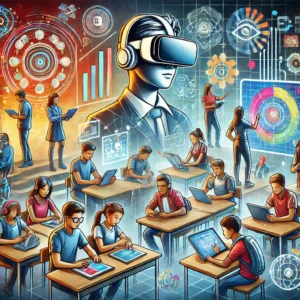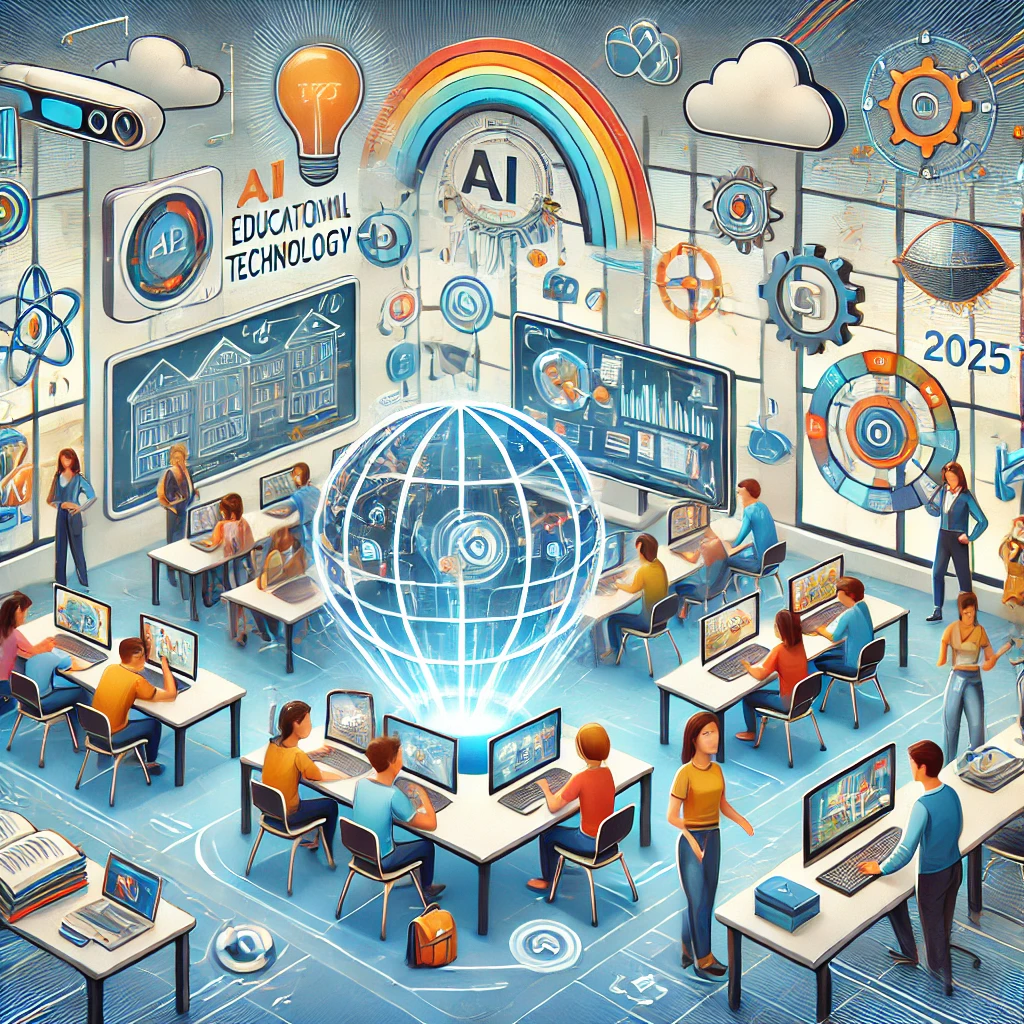Trends in Educational Technology 2025: Transforming Learning in the Digital Age
Introduction
Educational technology (EdTech) continues to evolve, driving transformative changes in the way we teach and learn. In 2025, EdTech trends are reshaping classrooms, making education more accessible, personalized, and immersive than ever before. This article delves into the cutting-edge trends in educational technology for 2025, their benefits, challenges, and what the future holds for learners and educators worldwide.
Why Educational Technology Matters in 2025
Enhancing Learning Experiences
- Personalized Learning: AI-driven platforms deliver tailored content based on individual learning styles and progress.
- Immersive Tools: Technologies like Virtual Reality (VR) and Augmented Reality (AR) create engaging, hands-on experiences for students.
Increasing Accessibility
- Global Reach: Online platforms provide education to remote or underserved areas, bridging geographical gaps.
- Assistive Technologies: Advanced tools support students with disabilities, such as AI-powered speech recognition and adaptive interfaces.
Preparing for the Future
- 21st-Century Skills: Students gain proficiency in critical areas like coding, problem-solving, and digital literacy.
- Collaborative Learning: Online tools enable seamless collaboration, fostering teamwork and innovation.

Top Trends in Educational Technology 2025
1. Artificial Intelligence (AI)
AI continues to revolutionize education by enabling adaptive learning platforms and automating administrative tasks.
- Adaptive Learning Systems: AI tailors lessons based on student performance, ensuring personalized learning experiences.
- AI Chatbots: Virtual assistants provide instant support, answering questions and offering guidance.
- Predictive Analytics: Identifying students at risk and recommending interventions to improve outcomes.
2. Virtual Reality (VR) and Augmented Reality (AR)
These immersive technologies redefine traditional learning environments.
- Virtual Field Trips: Students explore historical landmarks or scientific phenomena without leaving the classroom.
- AR-Enhanced Textbooks: Interactive 3D models bring complex concepts to life.
- Skill Simulations: Medical and engineering students practice in realistic, risk-free virtual environments.
3. Gamification
Game-based learning keeps students motivated and engaged.
- Reward Systems: Points, badges, and leaderboards encourage progress.
- Educational Games: Interactive gameplay helps students grasp challenging subjects.
- Story-Based Learning: Narratives immerse learners in problem-solving scenarios.
4. Learning Management Systems (LMS)
LMS platforms remain essential for organizing and delivering educational content.
- Integrated Tools: Platforms like Moodle and Canvas streamline assignments, grading, and communication.
- Remote Learning Features: Support hybrid and fully online classrooms.
- Data Analytics: Monitor student engagement and identify areas for improvement.
5. Blockchain Technology
Blockchain ensures secure and transparent record-keeping in education.
- Digital Credentials: Verifiable diplomas and certifications stored on the blockchain.
- Decentralized Learning Records: Students own and control their academic achievements.
- Fraud Prevention: Safeguarding the integrity of educational qualifications.
6. Big Data and Analytics
Data-driven decision-making empowers educators and institutions.
- Learning Insights: Analytics reveal student strengths and weaknesses.
- Curriculum Optimization: Identifying gaps and tailoring content to meet student needs.
- Behavioral Predictions: Anticipate trends in student engagement and performance.
7. Internet of Things (IoT)
IoT enhances connectivity and automation in educational settings.
- Smart Classrooms: Devices automate attendance, lighting, and environmental controls.
- Interactive Tools: IoT-enabled smartboards and connected devices enhance participation.
- Real-Time Feedback: Sensors and tools provide immediate insights during lessons.
8. Microlearning
Bite-sized content delivery improves retention and flexibility.
- Short Lessons: Videos and infographics convey concepts quickly.
- Mobile Learning: Access materials on smartphones for learning on-the-go.
- Customization: Tailored micro-courses for individual needs.
9. Robotics in Education
Robots make learning interactive and practical.
- STEM Focus: Robots teach programming, engineering, and math skills.
- Problem-Solving Activities: Encourage critical thinking and innovation.
- Engagement for Young Learners: Robots simplify complex concepts through play.
10. Cloud Computing
Cloud-based solutions simplify resource sharing and collaboration.
- Remote Access: Students and educators can access materials anywhere.
- Cost Efficiency: Reduce reliance on physical infrastructure and textbooks.
- Collaboration Tools: Platforms like Google Workspace enable teamwork.

Advantages of Educational Technology in 2025
1. Personalized Learning
Adaptive technologies cater to individual learning needs and preferences.
2. Increased Engagement
Interactive tools and immersive experiences make lessons more captivating.
3. Global Accessibility
Online platforms bring education to every corner of the world.
4. Support for Diverse Learning Styles
Visual, auditory, and kinesthetic learners benefit from varied digital tools.
5. Cost Efficiency
Digital resources reduce expenses on physical materials and infrastructure.
Disadvantages of Educational Technology
1. Digital Divide
Not all students have equal access to technology, exacerbating inequalities.
2. Over-Reliance on Technology
Dependence on digital tools may reduce critical thinking and problem-solving skills.
3. Privacy Concerns
Data breaches and unauthorized access to student information remain risks.
4. Health Impacts
Prolonged screen time can lead to eye strain and reduced physical activity.
5. Implementation Challenges
Schools may face issues with infrastructure, training, and maintenance.
Future of Educational Technology
1. AI-Driven Education
AI will further personalize learning and automate administrative tasks.
2. Global Virtual Classrooms
VR will connect students and educators across the globe in real-time.
3. Lifelong Learning Platforms
EdTech will support continuous learning through micro-courses and certifications.
4. Integration with Smart Cities
IoT-enabled schools will align seamlessly with smart city infrastructures.
FAQs:
Q1: What are the latest trends in educational technology for 2025?
AI, VR, AR, gamification, IoT, and blockchain are among the top trends revolutionizing education in 2025.
Q2: How does AI impact education?
AI personalizes learning experiences, provides real-time feedback, and supports educators with predictive analytics.
Q3: What are the benefits of educational technology?
EdTech enhances engagement, accessibility, collaboration, and cost-efficiency while supporting diverse learning styles.
Q4: What challenges come with educational technology?
Challenges include the digital divide, privacy risks, over-reliance on technology, and implementation difficulties.
Q5: What is the future of EdTech?
The future includes AI-driven adaptive learning, global virtual classrooms, and lifelong learning platforms integrated with smart city ecosystems.
Conclusion
The trends in educational technology for 2025 highlight the immense potential of digital tools in transforming learning experiences. While challenges like the digital divide and privacy concerns persist, advancements in AI, VR, IoT, and blockchain promise a brighter, more inclusive future for education. By embracing these innovations, educators can equip students with the skills and knowledge needed to thrive in a rapidly changing world.